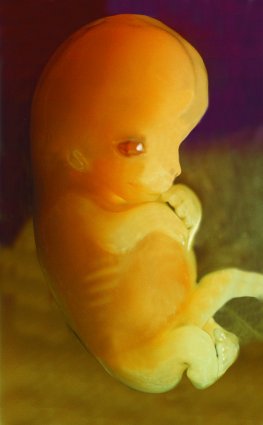
For you created my inmost being;
you knit me together in my mother’s womb.
I praise you because I am fearfully
and wonderfully made;
your works are wonderful,
I know that full well.
Psalm 139:13-14
The age of an unborn child is most often defined by gestational age, which is measured from the first day of the last normal menstrual period. Because some women have irregular periods, other ways are also used to help date the pregnancy. One way is to measure the length of the unborn child by ultrasound.
At fertilization (when the male sperm enters the female egg), the unborn child has his or her own unique set of DNA material — or genes — half from the mother and half from the father. The DNA is the blueprint for growth and development of all cells throughout life. DNA determines all of the baby’s physical characteristics such as gender; the shape of the nose and ears; and the color of the hair, eyes, and skin.
During the first 8 weeks, the unborn child is known as an embryo. After that time the unborn child is known as a fetus. It is during the first ten weeks of pregnancy that the unborn child is most likely to be affected by things such as alcohol, nicotine in cigarettes or other tobacco products, some prescription medicines or over-the-counter drugs, illegal drugs (like heroin, cocaine, or marijuana), viruses (like German measles), X rays, radiation therapy, or accidental exposure to radiation, and vitamin deficiencies (such as folic acid).
At 4 weeks gestation the brain, spinal cord, heart, stomach, intestines, eyes, and ears begin to form. Bone tissue is growing. Weight is less than one ounce and the length is less than 1/8 inch.
At 6 weeks gestation the lungs are beginning to form. Brain activity can be recorded. Eyes are present, but no eyelids yet. Heart is more developed and beating. Early reflexes develop. Hands and feet have fingers and toes, but may still be webbed. Length is less than 1/4 inch.
At 8 weeks gestation all essential organs have begun to form. Elbows and toes are visible. Fingers have grown to the first joint. Facial features: the eyes, nose, lips, and tongue continue to develop. Outer ears begin to take shape. Organs begin to be controlled by the brain. Length is about 1/2 to 3/4 inch.

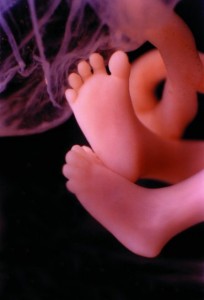
At 10 weeks gestation the unborn child is now called a fetus, rather than an embryo. The head is half the length of the body. Arms and legs are long and thin. Hands can make a fist. Red blood cells are produced.
At 12 weeks gestation the neck is present and the face well formed. Eyelids close and will reopen at about 24 weeks. Tooth buds appear. Arms and legs move. All body parts and organs are present. Fibers that carry pain to the brain are developed. Definitive signs of male and female gender are present. A heartbeat can be heard with electronic devices.
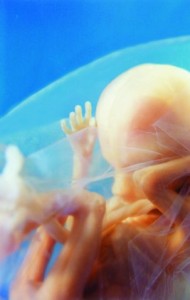
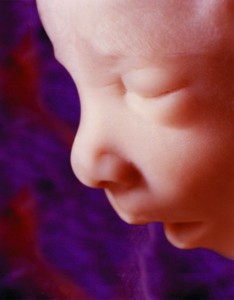 At 14 weeks gestation the skin is almost transparent. The mouth makes sucking motions. Amniotic fluid is swallowed. Sweat glands develop. Liver and pancreas are starting to work.
At 14 weeks gestation the skin is almost transparent. The mouth makes sucking motions. Amniotic fluid is swallowed. Sweat glands develop. Liver and pancreas are starting to work.
At 16 weeks gestation swallowing and chest movements are clearly present. Mother may feel movement. Head and body become proportional. Neck takes shape. Weight is about five ounces.
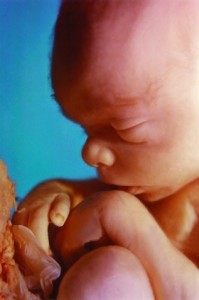 At 18 weeks gestation the arms and legs begin to punch and kick. Fingernails are well formed. The unborn child can suck its thumb. Taste buds are present. Male or female gender is evident. A protective waxy coating is present on the skin.
At 18 weeks gestation the arms and legs begin to punch and kick. Fingernails are well formed. The unborn child can suck its thumb. Taste buds are present. Male or female gender is evident. A protective waxy coating is present on the skin.
At 20 weeks gestation some experts have conclude that the unborn child is able to feel pain. Skin becomes less transparent as fat begins to deposit. Eyebrows and lashes appear. Breathing-like movements become regular and are detected by ultrasound, but the lungs have not developed enough to permit survival if birth occurs. The unborn child turns its body.
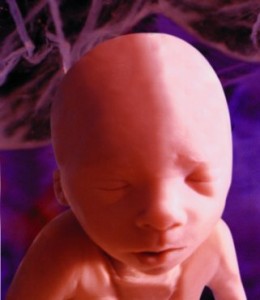 At 22 weeks gestation the rapid brain growth continues. Eyebrows and eyelashes are well formed. Eyes are fully functional and capable of movement. Vocal cords are active. Reflexes are present. Weight is about one pound.At 24 weeks gestation unique footprints and fingerprints are present. Outside sounds can be heard. Actions such as hiccupping, squinting, smiling, and frowning may be seen through ultrasound. Lungs have developed such that some premature babies may survive. Weight is about 1 to 11/2 pounds.
At 22 weeks gestation the rapid brain growth continues. Eyebrows and eyelashes are well formed. Eyes are fully functional and capable of movement. Vocal cords are active. Reflexes are present. Weight is about one pound.At 24 weeks gestation unique footprints and fingerprints are present. Outside sounds can be heard. Actions such as hiccupping, squinting, smiling, and frowning may be seen through ultrasound. Lungs have developed such that some premature babies may survive. Weight is about 1 to 11/2 pounds.
At 26 weeks gestation the central nervous system is developed enough to control some body functions. Eyelids open, close and can perceive light. Lungs have further matured and breathing is possible. The unborn child exercises muscles by kicking and stretching. Weight is about 11/2 to 2 pounds. Length is about 9 to 10 inches.
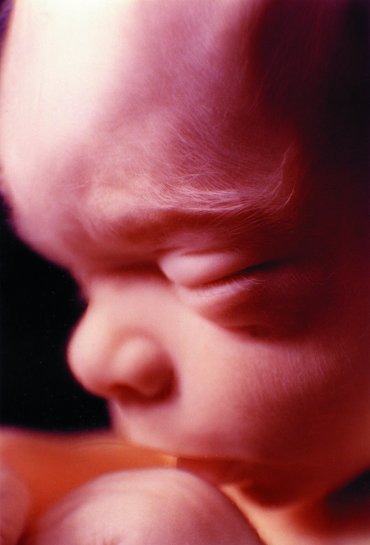 At 28 weeks gestation brain-wave patterns resemble those of a full term baby. Another person can hear a heartbeat by listening to the pregnant woman’s abdomen. There is a good chance of survival if birth occurs at this stage of development. Weight is about 2 to 21/4 pounds. Length is about 10 to 13 inches
At 28 weeks gestation brain-wave patterns resemble those of a full term baby. Another person can hear a heartbeat by listening to the pregnant woman’s abdomen. There is a good chance of survival if birth occurs at this stage of development. Weight is about 2 to 21/4 pounds. Length is about 10 to 13 inches
At 30 weeks gestation the central nervous system has increased control over body functions. Rhythmic breathing movements occur. Lungs are not fully mature. Bones are fully developed, but still soft and pliable. Weight is about 21/2 to 3 pounds. Length is about 15 to 16 inches.
At 32 weeks gestation the lungs are still developing. Body temperature is partially under control. Skin is thicker, with more color. Connections between the nerve cells in the brain have increased. Weight is about 3 to 3 3/4 pounds. Length is about 16 to 17 inches.
At 34 weeks gestation ears have begun to hold shape. Eyes open during alert times and close during sleep. Weight is about 4 to 41/2 pounds. Length is about 17 to 18 inches.
At 36 weeks gestation fine hair begins to disappear. Body fat has increased. Fingernails reach the end of the fingertips. Weight is about 5 to 6 pounds. Length is about 16 to 19 inches
At 38 weeks gestation a newborn is considered full-term at 38 weeks. Fingernails extend beyond the fingertips. Small breast buds are present on both sexes. The unborn child can grasp firmly and turn toward a light source. Average weight is greater than 6 pounds. Length is about 19 to 21 inches.